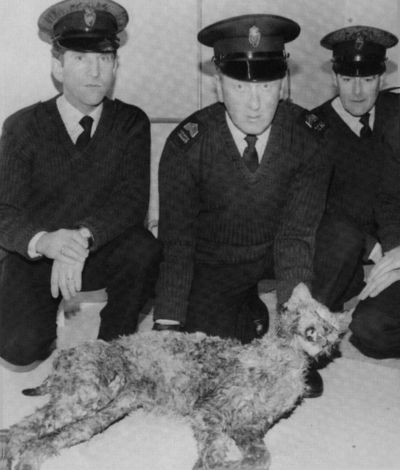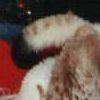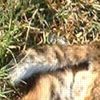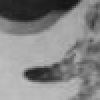
Please send us your comments on the following photos 
Fintona caracal
See Caracal shot at Fintona for information about this photograph.

Hi there all you cat identification experts! I could do with some help with confirming the identification of the above animal.
Some of you may well recognise the incident and remember what it was
reported to be. But I'd be interested in your opinion from the photo
rather than the reports in the press.
Thanks!
Chris Smith, Scottish Big Cats
It's ex cat :-)
The short tail suggests a lynx or bobcat. The ears seem on the small side for a caracal - see attachment.
Any more info on where it was found etc.?
George Markie, Scottish Big Cats
Interesting photo, and I believe its one of the rare ones that can be narrowed down to one of two species, either bobcat or Siberian Lynx.
The large size is more typical of the lynx but bobcats will reach this size occasionally. The tail is pointed rather than stubby which suggests bobcat, but the white streak underneath isnt apparent. If the image was in color it would be reasonably easy to identify with certainty. It most definitely isnt a caracal or a Canadian Lynx so the Siberian or Rufus would be the only two choices in my opinion.
Regards
Ben Willis, Scottish Big Cats
Good to know that I'm not the only one who thought it looked like a Eurasian lynx. According to the press reports it was actually identified as a caracal!
Chris Smith, Scottish Big Cats
 |
 |
 | Siberian Lynx | Bobcat | Fintona cat |
|---|
This image shows the tapered tail of a bobcat. I think this more resembles the cat in question.The second image shows a Siberian Lynx with the puffy tail and the black tip. Since this does look more tapered and smaller in the b&w photo I'm inclined to say the animal is a bobcat. Most people who own the Siberians will agree that they are much less prone to escape than bobcats. The nasty temperment of the bobcat would also be more likely to cause it to be released.
Whichever it is, a pelt or a good photograph should easily identify the cat. For the most part, the white streak under the tail is considered infallibe in distinguishing bobcats from the lynx.
What do you think ?
Ben Willis, Scottish Big Cats
The animal in question looks a bit emaciated and filthy, but to me the furriness and general size would indicate a sub-adult Eurasian lynx, or a bobcat. I can't imagine what an Iberian lynx would be doing in NI, but maybe the pet trade is further diminishing their numbers!
Caracals have quite smooth, short-haired coats, fairly uniform in colour.
If there is a substantial pet trade in exotic cats in Ireland, could they be imported to Scotland easily on the ferry? Are there any checks?
Allan Paul, Scottish Big Cats
Excellent point, Allan. I saw on Reporting Scotland a couple of weeks back that Customs & Excise officers had just about been done away with and that Scotland is now more or less an open door for smugglers. I guess that means exotic cats could possibly be smuggled in without too much difficulty.
Chris Smith, Scottish Big Cats Interesting image from Ireland - pretty sure it's not a Caracal - some type of lynx yes - feet not very visible but they look quite big and furry. It's an interesting one but I'm 90% certain that is not a caracal. A caracal would have the long legs & small head (relative to body) that this shows, but the ears are way too small, and the colour appears very light for a caracal (although that may be poor exposure on the photography). The tail looks pointed which according to my reference guides would make it more likely a lynx but not sure on the differences between Canadian & European /Siberian lynx. If it were an escaped pet (the report mentioned a collar?) I would speculate a Siberian origin was more likely (a friend of mine in customs & excise mentioned once that Russian far east was a source of a lot of wildlife smuggling) I'm far from an expert, and no doubt Ben will correct if necessary, but I believe that one of the major differences is the size. Eurasian and Canadian lynx appear to be the most similar members of the genus and were previously thought to be cospecific. However, Bobcat, Canadian Lynx and Iberian lynx are all fairly small and indeed behave like smaller cats, whereas Eurasian lynx are more like larger cats. Eurasian lynx are larger physically than the other species, they live much longer, have a larger hunting range, kill bigger prey, and have a lower population density. According to the Audubon field manual, the bobcat on average will range between 12 pounds in females, up to 40 pounds in males. The largest bobcat on record was killed in Michigan in the 1960's and weighed 69 pounds. It seems that we are not the only ones who think thisis a lynx, not a caracal. I found the following in Animals and Men number 9, 1996, Edited by Jonathan Downes. We're grateful to Peter Dignan for the following - it looks like the P&J got the animal's species correct, but not the continent. Chris Smith A WILD African Lynx roaming the countryside in Northern Ireland was shot dead in a field yesterday by police marksmen.
John Murray, Scottish Big Cats
Who identified it as a caracal originally? was it someone who knew there
stuff or was it a journalist with a field guide?
Phil Crosby, Scottish Big Cats
There are three main Eurasian lynx coat colours - striped, spotted, (ie tabbies) and pattern-less. It seems that in European lynx re-introduction programmes generally large, striped or spotted lynx have been released. However evidence suggests that the lynx in the Alps tended to be smaller and lack coat patterns.
Chris Smith, Scottish Big Cats
It is curious how the cat pictured could have been considered a caracal but something did occur to me. I have one edition of Funk & Wagnals which clearly and mistakenly pictures two caracals under the European Lynx lynx. I can only wonder what cat was pictured for the caracal. Is it possible that these books were used to reference the cat in question? If I still have the book I'll image the picture. These errors are not uncommon when it comes to cats and probably other subjects as well. I suspect this or some other erroneous source caused the cat to be misidentified.
Ben Willis, Scottish Big Cats
A lynx was shot dead by a R.U.C. marksman near the village of Fintona on the 18 th of February. The shooting followed days of reports of a 'young lion' in the area. The lynx, which was wearing a collar, was believed to have escaped from a private collection. The incident has increased demands for legislation in the province, which is not covered by the Dangerous Wild Animals Act of 1976. At present, there is no requirement for a license to keep a wild animal in private premises, and as shown on recent BBC television 'Watchdog' programmes, large cats are still being kept in makeshift cages in back gardens.
The night previous to the killing of the lynx, (which according to some reports was a carcal), another mystery cat was shot a few miles away. This was described as 'a wildcat', and was apparently 'tabby', but twice the size of a domestic cat.'
This is particularly interesting because, there are not, officially any wild cats in Ireland. In Dr. Karl Shuker's book 'Mystery Cats of the World,' and again in the editors forthcoming book, (Jonathan Downes) 'The Smaller Mystery Carnivores of the West Country', evidence by Scharff and others suggesting that not only have wildcats survived in parts of Ireland until recently, if not the present day, but that they appear to be F. lybcia rather than F. silvestris, is discussed. This corpse would, therefore have been a potentially invaluable piece of Cryptozoological evidence. Alison Downes contacted the R.U.C. and was told that the corpses were to be stuffed for the R.U.C. museum. We were promised photographs but at he time of writing, six weeks after the event, it seems unlikely that they will arrive.
Alison phoned again a few weeks later, to be told that the corpses were still waiting for autopsy, and that contrary to previous reports they will be probably destroyed. We have made tentative efforts to purchase the wildcat corpse for CFZ, but it seems highly unlikely that we shall succeed.
(CFZ is the Centre For Fortean Zoology run by Jonathan Downes who is the editor of Animals & Men.)
Chris Smith, Scottish Big CatsLynx shot
From the Press and Journal 19 th February 1996
There had been sightings for days of what police believed was a young lion in the Fintona area of County Tyrone.
The lynx is thought to have escaped from a collector.
Looks a bit rough for a Caracal. Could this be due to the amount of bullets fired?
An earlier report said there were two cats. Is this the other one?
It seems to have frightened the cops though. I feel sorry for the cat.
Terry Dye
When I first saw the photo I thought that the cat looked very much like a lynx. Everybody else seems to agree that it isn't a caracal and is most probably a European lynx. It is a shame that it was killed - Lara the Lynx in London doesn't know how lucky she was that it was the zoo who captured her not police marksmen. We had a similar incident a few years back when a wild boar escaped from a farm and was shot by the police after being on the loose for several weeks. People claimed he had tried to attack them. In fact, they would thunder across the field every time they saw somebody - because they were used to being fed. I think he just reacted as he always had don, and without the security of a fence, people, naturally enough, thought he was attacking, rather than just wanting a feed and a scratch.
There was something about the other cat in the Fortean Times. They said " Inquiries uncovered two other recent sightings. A week later, the sightings were thought to be of a large domestic cat called Dylan."
Chris Smith, Scottish Big Cats
Dear friends,
I'd like to say how amazed I am by the testimony of so called "wild cat
experts" these days, in the media!
How on earth could this cat photoed here with the officers, possibly be a caracal, for God's sake?!
Caracal's features, ears, fur type and colour, tail length and body size, are all starkly differant to this cat in the picture. It is very clearly a Euroasian Lynx, possibly Siberian.
Investigator & writer on wild cats.
That's definately a bobcat. I've seen them up real close while Deer hunting in Louisiana before,I had one at the base of the the tree my tree stand was in, looking up at me once! That's definitely a bobcat, and they are mean as hell.
Steve Miller
 |
 |
 |
| Return to index | Return to Scottish Big Cats | Return to Photo Album |